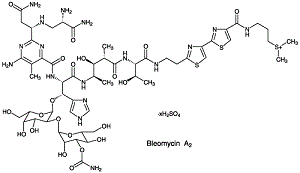| Cas No.: | 9041-93-4 |
| Chemical Name: | (3-(2'-((3S,6R,7S,8S,11S)-1-(6-amino-2-((S)-3-amino-1-(((S)-2,3-diamino-3-oxopropyl)amino)-3-oxopropyl)-5-methylpyrimidin-4-yl)-3-((R)-(((2R,3S,4S,5S,6S)-3-(((2R,3S,4S,5R,6R)-4-(carbamoyloxy)-3,5-dihydroxy-6-(hydroxymethyl)tetrahydro-2H-pyran-2-yl)oxy)-4, |
| Synonyms: | BLEO; BLM; BLEO cell; BLEO-cell; BLEOcell; Bleolem; Bleomycin sulfate; US brand name: Blenoxane. Blanoxan. |
| SMILES: | O=C(N[C@H](C)[C@@H](O)[C@H](C)C(N[C@H]([C@H](O)C)C(NCCC1=NC(C2=NC=C(C(NCCC[S+](C)C)=O)S2)=CS1)=O)=O)[C@H](NC(C3=C(C)C(N)=NC([C@H](CC(N)=O)NC[C@H](N)C(N)=O)=N3)=O)[C@H](C4=CNC=N4)O[C@H](O[C@H]5CO)[C@H]([C@@H](O)[C@@H]5O)O[C@H]6[C@@H](O)[C@H](OC(N)=O)[C@H]( |
| Formula: | C55H85N17O25S4 |
| M.Wt: | 1512.62 |
| Sotrage: | 2 years -20°C Powder, 2 weeks 4°C in DMSO, 6 months -80°C in DMSO |
| Description: | Bleomycin sulfate is a DNA synthesis inhibitor with potent antitumor activity. |
| In Vivo: | A short-range beta-emitting radionuclide combined to Bleomycin (In-111-BLMC) is a tumor-targeting agent in SCCs. Within 35 days the weight of nude mice increases 2.8±0.6g. At 25 and 35 days after tumor inoculations the tumor volumes are 111±51 mm3 and 874±577 mm3, respectively. The calculated doubling time is 3.86±0.76 days. SCC cell lines demonstrate different sensitivity to Bleomycin. Our SCC tumor xenograft model shows a rapid growth proper for radiochemotherapeutic studies using In-111-BLMC. The uptake of In-111-BLMC in vivo has been directly proportional to proliferation activity, and the tumors with high binding capacity could be predicted from animal model dose calculations[2]. At 7 and 14 days after Bleomycin (BLM) treatment, the signal of TGF-β1 is significantly stronger than that of the control group. At 28 days after treatment, the TGF-β1 signal became a little weaker. At 7 and 14 days of Bleomycin plus Dex group, the signal of TGF-β1 is also stronger than that of the control group. However, at 28 days, the TGF-β1 signal become weaker and is a little stronger than the level of control group. All the results are given by comparison of the average IOD value[4]. |
| In Vitro: | Bleomycin (BLM) is chosen as the best-studied micronucleus (MN) inducers in human lymphocytes with different mechanisms of genotoxicity. The most frequent Bleomycin-induced DNA lesions are single and double strand breaks and single apuinic/apyrimidinic sites. At the same time Bleomycin is true radiomimetic compound, resembling almost completely the genetic effect of ionizing radiation[1]. The IC50 value of Bleomycin sulfate for UT-SCC-19A cell line is 4.0±1.3 nM. UT-SCC-12A and UT-SCC-12B are both more resistant to Bleomycin (BLM); IC50 values are 14.2±2.8 nM and 13.0±1.1 nM, respectively[2]. Bleomycin (BLM) induces a significant increase in the percentage of aberrant cells (i.e., cells showing at least one aberration) and in the frequency of chromosomal aberrations per cell compare with control cultures 18 h after treatment (p<0.05)[3]. |

 To enhance service speed and avoid tariff delays, we've opened a US warehouse. All US orders ship directly from our US facility.
To enhance service speed and avoid tariff delays, we've opened a US warehouse. All US orders ship directly from our US facility.




















